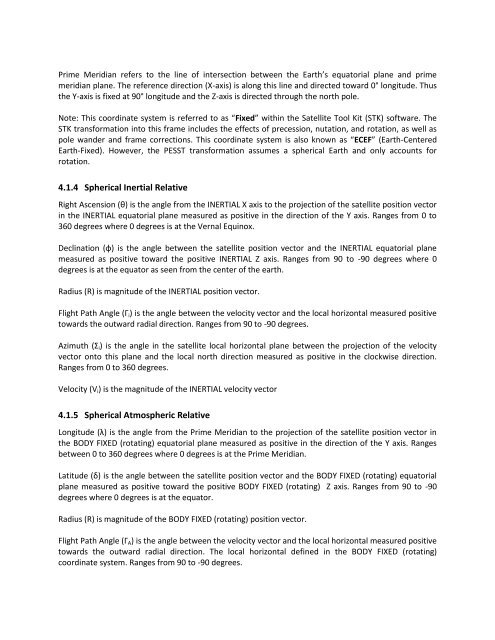SPORE Mission Design - Georgia Tech SSDL - Georgia Institute of ...
SPORE Mission Design - Georgia Tech SSDL - Georgia Institute of ...
SPORE Mission Design - Georgia Tech SSDL - Georgia Institute of ...
Create successful ePaper yourself
Turn your PDF publications into a flip-book with our unique Google optimized e-Paper software.
Prime Meridian refers to the line <strong>of</strong> intersection between the Earth’s equatorial plane and prime<br />
meridian plane. The reference direction (X-axis) is along this line and directed toward 0° longitude. Thus<br />
the Y-axis is fixed at 90° longitude and the Z-axis is directed through the north pole.<br />
Note: This coordinate system is referred to as “Fixed” within the Satellite Tool Kit (STK) s<strong>of</strong>tware. The<br />
STK transformation into this frame includes the effects <strong>of</strong> precession, nutation, and rotation, as well as<br />
pole wander and frame corrections. This coordinate system is also known as “ECEF” (Earth-Centered<br />
Earth-Fixed). However, the PESST transformation assumes a spherical Earth and only accounts for<br />
rotation.<br />
4.1.4 Spherical Inertial Relative<br />
Right Ascension (θ) is the angle from the INERTIAL X axis to the projection <strong>of</strong> the satellite position vector<br />
in the INERTIAL equatorial plane measured as positive in the direction <strong>of</strong> the Y axis. Ranges from 0 to<br />
360 degrees where 0 degrees is at the Vernal Equinox.<br />
Declination (φ) is the angle between the satellite position vector and the INERTIAL equatorial plane<br />
measured as positive toward the positive INERTIAL Z axis. Ranges from 90 to -90 degrees where 0<br />
degrees is at the equator as seen from the center <strong>of</strong> the earth.<br />
Radius (R) is magnitude <strong>of</strong> the INERTIAL position vector.<br />
Flight Path Angle (Γ i ) is the angle between the velocity vector and the local horizontal measured positive<br />
towards the outward radial direction. Ranges from 90 to -90 degrees.<br />
Azimuth (Σ i ) is the angle in the satellite local horizontal plane between the projection <strong>of</strong> the velocity<br />
vector onto this plane and the local north direction measured as positive in the clockwise direction.<br />
Ranges from 0 to 360 degrees.<br />
Velocity (V i ) is the magnitude <strong>of</strong> the INERTIAL velocity vector<br />
4.1.5 Spherical Atmospheric Relative<br />
Longitude (λ) is the angle from the Prime Meridian to the projection <strong>of</strong> the satellite position vector in<br />
the BODY FIXED (rotating) equatorial plane measured as positive in the direction <strong>of</strong> the Y axis. Ranges<br />
between 0 to 360 degrees where 0 degrees is at the Prime Meridian.<br />
Latitude (δ) is the angle between the satellite position vector and the BODY FIXED (rotating) equatorial<br />
plane measured as positive toward the positive BODY FIXED (rotating) Z axis. Ranges from 90 to -90<br />
degrees where 0 degrees is at the equator.<br />
Radius (R) is magnitude <strong>of</strong> the BODY FIXED (rotating) position vector.<br />
Flight Path Angle (Γ A ) is the angle between the velocity vector and the local horizontal measured positive<br />
towards the outward radial direction. The local horizontal defined in the BODY FIXED (rotating)<br />
coordinate system. Ranges from 90 to -90 degrees.
















